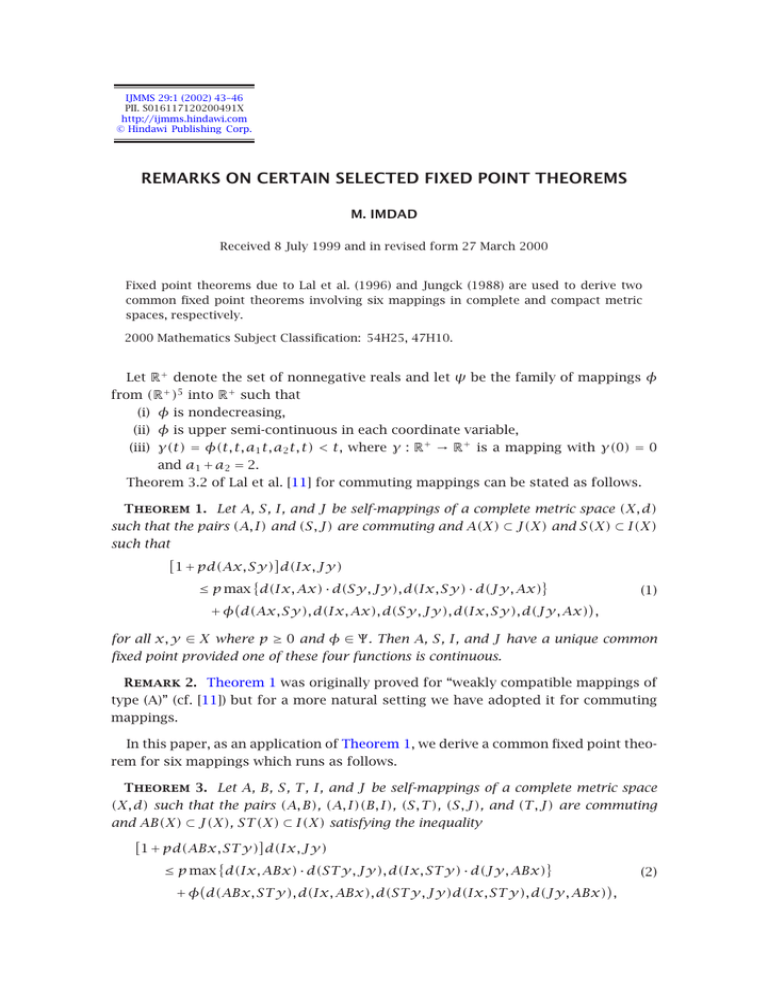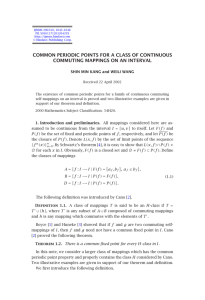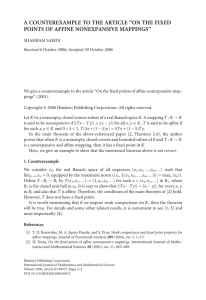REMARKS ON CERTAIN SELECTED FIXED POINT THEOREMS M. IMDAD
advertisement

IJMMS 29:1 (2002) 43–46 PII. S016117120200491X http://ijmms.hindawi.com © Hindawi Publishing Corp. REMARKS ON CERTAIN SELECTED FIXED POINT THEOREMS M. IMDAD Received 8 July 1999 and in revised form 27 March 2000 Fixed point theorems due to Lal et al. (1996) and Jungck (1988) are used to derive two common fixed point theorems involving six mappings in complete and compact metric spaces, respectively. 2000 Mathematics Subject Classification: 54H25, 47H10. Let R+ denote the set of nonnegative reals and let ψ be the family of mappings φ from (R+ )5 into R+ such that (i) φ is nondecreasing, (ii) φ is upper semi-continuous in each coordinate variable, (iii) γ(t) = φ(t, t, a1 t, a2 t, t) < t, where γ : R+ → R+ is a mapping with γ(0) = 0 and a1 + a2 = 2. Theorem 3.2 of Lal et al. [11] for commuting mappings can be stated as follows. Theorem 1. Let A, S, I, and J be self-mappings of a complete metric space (X, d) such that the pairs (A, I) and (S, J) are commuting and A(X) ⊂ J(X) and S(X) ⊂ I(X) such that 1 + pd(Ax, Sy) d(Ix, Jy) ≤ p max d(Ix, Ax) · d(Sy, Jy), d(Ix, Sy) · d(Jy, Ax) (1) + φ d(Ax, Sy), d(Ix, Ax), d(Sy, Jy), d(Ix, Sy), d(Jy, Ax) , for all x, y ∈ X where p ≥ 0 and φ ∈ Ψ . Then A, S, I, and J have a unique common fixed point provided one of these four functions is continuous. Remark 2. Theorem 1 was originally proved for “weakly compatible mappings of type (A)” (cf. [11]) but for a more natural setting we have adopted it for commuting mappings. In this paper, as an application of Theorem 1, we derive a common fixed point theorem for six mappings which runs as follows. Theorem 3. Let A, B, S, T , I, and J be self-mappings of a complete metric space (X, d) such that the pairs (A, B), (A, I)(B, I), (S, T ), (S, J), and (T , J) are commuting and AB(X) ⊂ J(X), ST (X) ⊂ I(X) satisfying the inequality 1 + pd(ABx, ST y) d(Ix, Jy) ≤ p max d(Ix, ABx) · d(ST y, Jy), d(Ix, ST y) · d(Jy, ABx) (2) + φ d(ABx, ST y), d(Ix, ABx), d(ST y, Jy)d(Ix, ST y), d(Jy, ABx) , 44 M. IMDAD for all x, y ∈ X where p ≥ 0 and φ ∈ Ψ . Then A, B, S, T , I, and J have a unique common fixed point provided one of these four mappings AB, ST , I, and J is continuous. Proof. We begin by observing that continuity of AB (resp., ST ) does not demand the continuities of the component maps A or B or both (resp., S or T or both). Since the pairs (A, B), (A, I), (B, I)(S, T ), (S, J), and (T , J) are commuting which force the pairs (AB, I) and (ST , J) to be commuting. After observing this we note that all the conditions of Theorem 1 for four mappings AB, ST , I, and J are satisfied, hence (in view of Theorem 1) AB, ST , I, and J have a unique common fixed point z. Here one can note that z also remains the unique common fixed point of the pairs (AB, I) and (ST , J) separately. Now it remains to show that z is also a common fixed point of A, B, S, T , I, and J. For this let z be the unique common fixed point of the pair (AB, I), then Az = A(ABz) = A(BAz) = AB(Az), Bz = B(ABz) = BA(Bz) = AB(Bz), Az = A(Iz) = I(Az), Bz = B(Iz) = I(Bz), (3) which shows that Az and Bz are other fixed points of the pair (AB, I) yielding thereby Az = Bz = Iz = ABz = z (4) in view of the uniqueness of common fixed point of the pair (AB, I). Similarly, it can be shown that z is also the unique common fixed point of S, T , ST , and J. This completes the proof. Remark 4. By choosing φ suitably one can derive improved versions of a multitude of relevant known common fixed point theorems involving six mappings especially those contained in Singh and Meade [14], Husain and Sehgal [5], Khan and Imdad [10], Jungck [6], Ćirić [1], S. L. Singh and S. P. Singh [13], Fisher [3, 4], Das and Naik [2], Kannan [9], Rhoades [12], and several others. Also setting p = 0 and choosing A, B, S, T , I, J, and φ suitably one can deduce the results proved in the above cited references and many others. Next we wish to indicate a similar result in compact metric spaces. For this purpose one can adopt a general fixed point theorem for commuting mappings in compact metric spaces due to Jungck [8], which was originally proved for compatible mappings (a notion due to Jungck [7]). Theorem 5 (see [8]). Let A, S, I, and J be self-mappings of a compact metric space (X, d) with A(X) ⊂ J(X) and S(X) ⊂ I(X). If the pairs (A, I) and (S, J) are commuting and d(Ax, Sy) < M(x, y), (5) for all x, y ∈ X where 1 M(x, y) = max d(Ix, Jy), d(Ix, Ax), d(Jy, Sy), d(Ix, Sy) + d(Jy, Ax) 2 (6) with M(x, y) > 0, then A, S, I, and J have a unique common fixed point provided all four mappings A, S, I, and J are continuous. REMARKS ON CERTAIN SELECTED FIXED POINT THEOREMS 45 As an application of Theorem 5 one can derive the following theorem in compact metric spaces involving six mappings. Theorem 6. Let A, B, S, T , I, and J be self-mappings of a compact metric space (X, d) with AB(X) ⊂ J(X) and ST (X) ⊂ I(X). If the pairs (A, B), (A, I)(B, I), (S, T ), (S, J), and (T , J) are commuting and d(ABx, ST y) < M(x, y), (7) for all x, y ∈ X where 1 M(x, y) = max d(Ix, Jy), d(Ix, ABx), d(Jy, ST y), d(Ix, ST y)+d(Jy, ABx) (8) 2 with M(x, y) > 0, then A, B, S, T , I, and J have a unique common fixed point provided all four mappings AB, ST , I, and J are continuous. Proof. The proof is essentially the same as that of Theorem 3, hence we omit the proof. Remark 7. By choosing A, B, S, T , I, and J suitably one can derive a multitude of known theorems. Acknowledgement. The author is grateful to both the learned referees for their pertinent remarks which has significantly improved the contents of an earlier version of this paper. References [1] [2] [3] [4] [5] [6] [7] [8] [9] [10] [11] [12] [13] L. B. Ćirić, Generalized contractions and fixed-point theorems, Publ. Inst. Math. (Beograd) (N.S.) 12(26) (1971), 19–26. K. M. Das and K. V. Naik, Common fixed-point theorems for commuting maps on a metric space, Proc. Amer. Math. Soc. 77 (1979), no. 3, 369–373. B. Fisher, Mappings with a common fixed point, Math. Sem. Notes Kobe Univ. 7 (1979), no. 1, 81–84. , Common fixed points of commuting mappings, Bull. Inst. Math. Acad. Sinica 9 (1981), no. 3, 399–406. S. A. Husain and V. M. Sehgal, On common fixed points for a family of mappings, Bull. Austral. Math. Soc. 13 (1975), no. 2, 261–267. G. Jungck, Commuting mappings and fixed points, Amer. Math. Monthly 83 (1976), no. 4, 261–263. , Compatible mappings and common fixed points, Int. J. Math. Math. Sci. 9 (1986), no. 4, 771–779. , Common fixed points for commuting and compatible maps on compacta, Proc. Amer. Math. Soc. 103 (1988), no. 3, 977–983. R. Kannan, Some results on fixed points, Bull. Calcutta Math. Soc. 60 (1968), 71–76. M. S. Khan and M. Imdad, Some common fixed point theorems, Glas. Mat. Ser. III 18(38) (1983), no. 2, 321–326. S. N. Lal, P. P. Murthy, and Y. J. Cho, An extension of Telci, Tas and Fisher’s theorem, J. Korean Math. Soc. 33 (1996), no. 4, 891–908. B. E. Rhoades, A comparison of various definitions of contractive mappings, Trans. Amer. Math. Soc. 226 (1977), 257–290. S. L. Singh and S. P. Singh, A fixed point theorem, Indian J. Pure Appl. Math. 11 (1980), no. 12, 1584–1586. 46 [14] M. IMDAD S. P. Singh and B. A. Meade, On common fixed point theorems, Bull. Austral. Math. Soc. 16 (1977), no. 1, 49–53. M. Imdad: Department of Mathematics, Aligarh Muslim University, Aligarh202002 (U.P.), India E-mail address: sengar1@bharatmail.com





